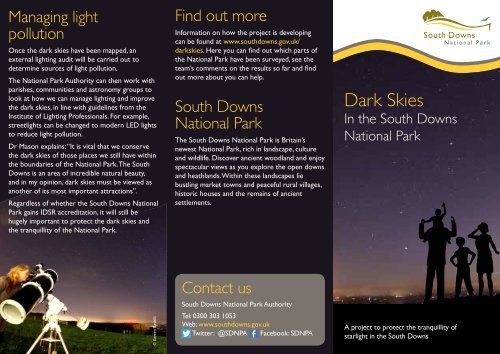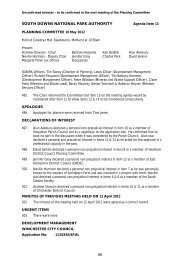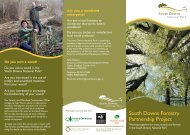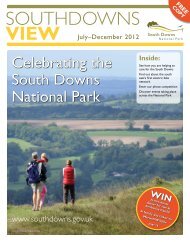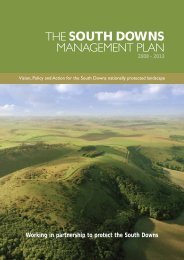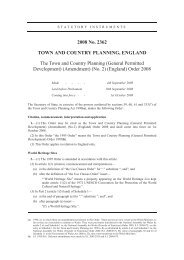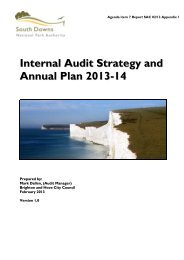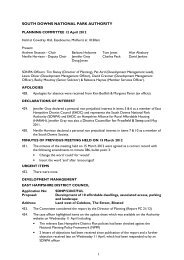Dark skies leaflet - South Downs National Park Authority
Dark skies leaflet - South Downs National Park Authority
Dark skies leaflet - South Downs National Park Authority
You also want an ePaper? Increase the reach of your titles
YUMPU automatically turns print PDFs into web optimized ePapers that Google loves.
Managing light<br />
pollution<br />
Once the dark <strong>skies</strong> have been mapped, an<br />
external lighting audit will be carried out to<br />
determine sources of light pollution.<br />
The <strong>National</strong> <strong>Park</strong> <strong>Authority</strong> can then work with<br />
parishes, communities and astronomy groups to<br />
look at how we can manage lighting and improve<br />
the dark <strong>skies</strong>, in line with guidelines from the<br />
Institute of Lighting Professionals. For example,<br />
streetlights can be changed to modern LED lights<br />
to reduce light pollution.<br />
Dr Mason explains: “It is vital that we conserve<br />
the dark <strong>skies</strong> of those places we still have within<br />
the boundaries of the <strong>National</strong> <strong>Park</strong>. The <strong>South</strong><br />
<strong>Downs</strong> is an area of incredible natural beauty,<br />
and in my opinion, dark <strong>skies</strong> must be viewed as<br />
another of its most important attractions”.<br />
Regardless of whether the <strong>South</strong> <strong>Downs</strong> <strong>National</strong><br />
<strong>Park</strong> gains IDSR accreditation, it will still be<br />
hugely important to protect the dark <strong>skies</strong> and<br />
the tranquillity of the <strong>National</strong> <strong>Park</strong>.<br />
Find out more<br />
Information on how the project is developing<br />
can be found at www.southdowns.gov.uk/<br />
dark<strong>skies</strong>. Here you can find out which parts of<br />
the <strong>National</strong> <strong>Park</strong> have been surveyed, see the<br />
team’s comments on the results so far and find<br />
out more about you can help.<br />
<strong>South</strong> <strong>Downs</strong><br />
<strong>National</strong> <strong>Park</strong><br />
The <strong>South</strong> <strong>Downs</strong> <strong>National</strong> <strong>Park</strong> is Britain’s<br />
newest <strong>National</strong> <strong>Park</strong>, rich in landscape, culture<br />
and wildlife. Discover ancient woodland and enjoy<br />
spectacular views as you explore the open downs<br />
and heathlands. Within these landscapes lie<br />
bustling market towns and peaceful rural villages,<br />
historic houses and the remains of ancient<br />
settlements.<br />
<strong>Dark</strong> Skies<br />
In the <strong>South</strong> <strong>Downs</strong><br />
<strong>National</strong> <strong>Park</strong><br />
© Darren Baskill<br />
Contact us<br />
<strong>South</strong> <strong>Downs</strong> <strong>National</strong> <strong>Park</strong> <strong>Authority</strong><br />
Tel: 0300 303 1053<br />
Web: www.southdowns.gov.uk<br />
Twitter: @SDNPA Facebook: SDNPA<br />
A project to protect the tranquillity of<br />
starlight in the <strong>South</strong> <strong>Downs</strong>
What are<br />
<strong>Dark</strong> Skies?<br />
The <strong>South</strong> <strong>Downs</strong> <strong>National</strong> <strong>Park</strong> is a great place<br />
to experience the best free light show there is,<br />
with twinkling stars, whizzing shooting stars and<br />
bright planets scattered across the sky.<br />
Less than 10% of the UK population can see the<br />
beauty of a natural night sky full of stars and the<br />
south east is the most light-polluted regions of<br />
the UK.<br />
Our street and outdoor lighting affects the dark<br />
night <strong>skies</strong>, and the orange glow from our towns<br />
and cities is visible for miles around.<br />
<strong>Dark</strong> Skies is the term given to areas that are<br />
relatively free from this pollution and this <strong>leaflet</strong><br />
explains their importance to our wildlife and<br />
starry <strong>skies</strong>.<br />
Why are they<br />
important?<br />
Light pollution is an increasing problem across<br />
the country. It threatens ecologically sensitive<br />
habitats and reduces astronomical opportunities.<br />
With nearly a third of vertebrates and 60% of<br />
invertebrates being nocturnal, several species<br />
depend on darkness for survival. High levels of<br />
light pollution cause them to become disoriented,<br />
resulting in decreased reproduction and reduced<br />
foraging for food.<br />
Dr Mason MBE, from the <strong>South</strong> <strong>Downs</strong><br />
Planetarium, says: “This is not just about<br />
stargazing, it is about preserving the night-time<br />
environment for the benefit of all the animals,<br />
birds and insects that thrive at night”.<br />
Even in the countryside, unnecessary, poorly<br />
aimed and overly bright floodlights and security<br />
lights can affect the day-night cycles, behaviour,<br />
feeding and mating patterns of bats, birds, moths,<br />
glow-worms and many other species.<br />
How we can save<br />
the dark <strong>skies</strong><br />
One of the ways to protect the dark <strong>skies</strong> (and<br />
therefore the wildlife), is to apply for International<br />
<strong>Dark</strong> Skies Reserve (IDSR) status. There are only<br />
a handful of locations in the world that have been<br />
granted this status, so it’s seen as something<br />
very special.<br />
To see whether the <strong>South</strong> <strong>Downs</strong> has the<br />
potential to become a <strong>Dark</strong> Sky Reserve, we<br />
must first measure and map the quality of the sky.<br />
This project has already begun, and initial findings<br />
show that there are some impressive areas where<br />
you can see the Milky Way, the Andromeda galaxy<br />
and the Orion Nebula with the naked eye and<br />
binoculars.<br />
Once this mapping is complete, we can draw an<br />
estimated dark sky core boundary, which shows<br />
the darkest area of the <strong>National</strong> <strong>Park</strong>. This is<br />
required for the application to the International<br />
<strong>Dark</strong> Sky Association, and it identifies where the<br />
critical areas – those at threat from increasing<br />
light pollution – are.<br />
M27 Dumbell Nebula. Steve Futcher M33 Triangulum Galaxy. Simon <strong>Downs</strong> M42 Orion Nebula. Steve Futcher NGC 7380. Wizard Nebula. Simon <strong>Downs</strong> Saturn. Phil Reed and Steve Knight<br />
M51 Whirlpool Galaxy


